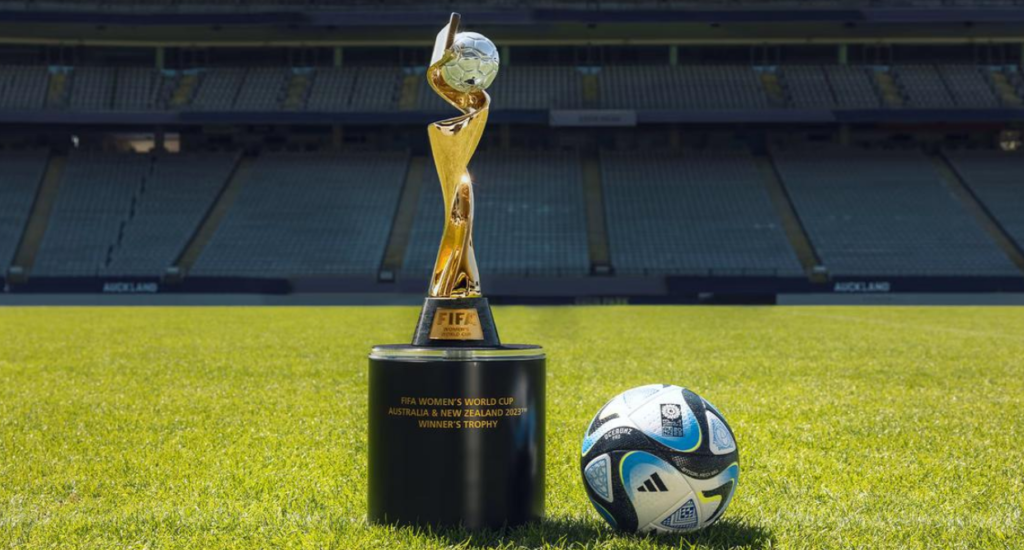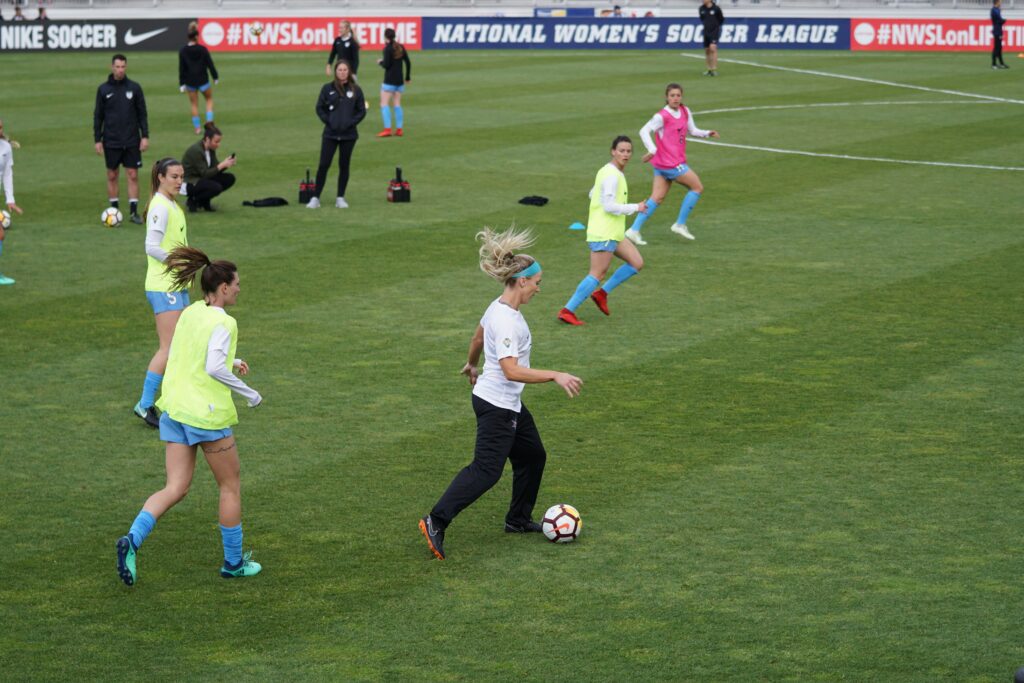The craze of The FIFA Women’s World Cup has already on peak. As we know FIFA Women’s World Cup is the most prestigious international football tournament for women’s national teams. Firstly it was held in 1991, the tournament has grown in popularity and stature over the years and is now one of the most watched sporting events in the world. The 2023 FIFA Women’s World Cup will be held in Australia and New Zealand and is set to be the biggest and best tournament yet, with 32 teams competing for the title, promising a feast of football action.

Key Facts and Figures about the FIFA Women’s World Cup:
The first FIFA Women’s World Cup was held in 1991 in China, won by the United States.
The most successful team in the history of the tournament is the United States, with four titles.
The current champions are the Netherlands, who won the 2019 tournament in France.
The most-watched FIFA Women’s World Cup final was the 2019 final between the United States and the Netherlands, watched by an estimated 1.12 billion people worldwide.
The History of the FIFA Women’s World Cup:
The FIFA Women’s World Cup has a long and rich history. It was first held in 1991 in China, and the United States won the inaugural tournament. Since then, the tournament has been held every four years, witnessing the rise of women’s football as a global sport. The early years were dominated by the United States, winning the first three tournaments. However, other teams like Norway, Germany, and Japan have also become competitive and claimed titles in recent years.
The 2019 FIFA Women’s World Cup marked a turning point for the tournament. The final between the United States and the Netherlands became the most-watched in history, attracting an estimated 1.12 billion viewers worldwide. The tournament also recorded record attendances, with over 1.3 million fans attending matches. To know All about FIFA Women’s World Cup | 2023 keep reading.
Impact of the FIFA Women’s World Cup:
The FIFA Women’s World Cup has had a significant impact on women’s football globally. It has raised the sport’s profile and inspired girls and women to participate in football. Additionally, it has improved the financial rewards for women’s footballers, with the prize money for the 2023 tournament increased to $400 million, a substantial rise from the $10 million awarded in 1991.
The tournament has also driven improvements in infrastructure, with many countries building new stadiums and training facilities to host the event. This has created a more professional environment for women’s footballers, facilitating skill development and growth.
The Future of the FIFA Women’s World Cup:
The future of the FIFA Women’s World Cup looks promising. The tournament’s popularity is increasing, and it is expected to grow in stature in the coming years. The 2023 tournament, jointly hosted by Australia and New Zealand, is set to be historic, with a record number of spectators and two countries sharing the hosting responsibilities for the first time.
The FIFA Women’s World Cup has come a long way since its inception and has played a significant role in promoting women’s football worldwide. As the tournament continues to gain momentum, it will undoubtedly continue to inspire and empower girls and women, reinforcing their belief in their football dreams and aspirations. The world eagerly awaits the 2023 edition, looking forward to a thrilling display of talent and skill from teams across the globe. this is The Future of the FIFA Women’s World Cup.

Here are some of the key dates for the FIFA Women’s World Cup 2023:
Opening match: July 20, 2023 at Eden Park, Auckland, New Zealand
Eden Park, Auckland, New Zealand
Eden Park, Auckland, New Zealand
Final: August 20, 2023 at Stadium Australia, Sydney, Australia
Stadium Australia, Sydney, Australia
Stadium Australia, Sydney, Australia
Qualification draw: February 24, 2022
Group stage: July 20-July 30, 2023
Knockout stage: August 2-August 20, 2023
Group A: New Zealand (host), Norway, Philippines, Switzerland
Group B: Australia (host), Republic of Ireland, Nigeria, Canada
Group C: Spain, Costa Rica, Zambia, Japan
Group D: England, Haiti, Denmark, China
Group E: The United States, Vietnam, the Netherlands, Portugal
Group F: France, Jamaica, Brazil, Panama
Group G: Sweden, Switzerland, Italy, Argentina
Group H: Germany, Morocco, Colombia, South Korea.
The tournament will be played in 13 stadiums across Australia and New Zealand. The stadiums are:
Accor Stadium, Sydney, Australia
Bankwest Stadium, Parramatta, Australia
Brisbane Stadium, Brisbane, Australia
Eden Park, Auckland, New Zealand
Etihad Stadium, Melbourne, Australia
FFA Stadium, Sydney, Australia
Hindmarsh Stadium, Adelaide, Australia
Moreton Bay Stadium, Burpengary, Australia
North Harbour Stadium, Albany, New Zealand
Perth Rectangular Stadium, Perth, Australia
Waikato Stadium, Hamilton, New Zealand
FIFA Women’s World Cup 2023 Schedule for next two days:
Thursday, July 20
Group A: New Zealand vs. Norway
Group B: Australia vs. Ireland
Friday, July 21
Group B: Nigeria vs. Canada
Group A: Philippines vs. Switzerland
Group C: Spain vs. Costa Rica
Prize Money for Winners: –
The total prize money for the tournament is $400 million, which is a significant increase from the $30 million that was awarded to the winners of the 2019 tournament. The prize money will be distributed as follows:
Winner: $42 million
Runner-up: $28 million
Third place: $24 million
Fourth place: $20 million
Quarterfinalists: $17 million
Round of 16 losers: $12 million
Group stage losers: $9 million
The first FIFA Women’s World Cup was held in China in 1991 and was won by the United States. Since then The tournament is been held every four years since then and has grown in popularity and stature with each passing edition. The most-watched FIFA Women’s World Cup final ever was the 2019 FIFA Women’s World Cup in France, with an approximate 1.12 billion people tuning in to watch the match.
FIFA Women’s World Cup: Best performing Teams so far.
The FIFA Women’s World Cup is an illustrious international football tournament that showcases the best of women’s national teams from around the globe. Since its inception in 1991, the tournament has grown exponentially in popularity, attracting millions of viewers and establishing itself as one of the most-watched sporting events worldwide. As we gear up for the 2023 FIFA Women’s World Cup in Australia and New Zealand, let’s take a closer look at some of the remarkable achievements in the tournament’s history.
Most Successful Team: The United States
When it comes to conquering the FIFA Women’s World Cup, one team stands above the rest – the United States Women’s National Team (USWNT). The USWNT has been an unstoppable force in the tournament, clinching the title an impressive four times. Their victories came in 1991 in China, 1999 in the United States, 2015 in Canada, and most recently, in 2019 in France. With each triumph, the USWNT has left an indelible mark on the tournament’s legacy. So now i believe as a reader we have briefly All about FIFA Women’s World Cup | 2023.
Top Five Players in FIFA Women’s World Cup History
Selecting the top five players in the history of the FIFA Women’s World Cup is no easy task, given the subjective nature of player assessments. However, certain players have undeniably made an indomitable impact and are widely regarded as some of the best in the tournament’s history. Let’s explore the profiles of these legendary footballers:
Marta (Brazil): Known as the “Queen of Football,” Marta is undoubtedly one of the greatest women’s footballers of all time. Her list of accolades includes multiple FIFA Women’s World Player of the Year awards. Leading Brazil to the final in 2007, Marta has been an instrumental force in her team’s success.
Abby Wambach (United States): Abby Wambach is celebrated as one of the most prolific goal scorers in Women’s World Cup history. A key player for the USWNT during their 2015 triumph, Wambach earned the tournament’s Golden Boot as the top scorer.
Birgit Prinz (Germany): A dominant force in German women’s football, Birgit Prinz’s legacy is undeniable. She clinched the Golden Boot in the 2003 Women’s World Cup and played a crucial role in Germany’s back-to-back victories in 2003 and 2007.
Homare Sawa (Japan): Homare Sawa etched her name in history with her exceptional leadership and performances during Japan’s historic victory in the 2011 Women’s World Cup. Earning both the Golden Boot and Golden Ball, Sawa’s contributions were invaluable to her team’s success.
Michelle Akers (United States): Michelle Akers holds a revered place in the pantheon of women’s football as a trailblazer and a pioneer of the sport. As the top scorer in the inaugural 1991 Women’s World Cup, Akers played a pivotal role in the USWNT’s early triumphs.
It’s crucial to remember that player rankings are subjective and can vary based on different opinions and timeframes. As women’s football continues to evolve, new stars are destined to emerge and make their mark on the Women’s World Cup in the future.
Why India’s Women’s Team is Yet to Participate in the FIFA Women’s World Cup?
The absence of India’s women’s national team from the FIFA Women’s World Cup can be attributed to several contributing factors:
Development of Women’s Football: Historically, women’s football in India has received less attention and investment compared to its male counterpart. The lack of adequate infrastructure, resources, and opportunities has hindered the growth and development of the women’s game in the country.
Competitive Landscape: The Asian Football Confederation (AFC) is highly competitive, with several formidable teams vying for limited World Cup slots. Countries like Japan, Australia, China, and South Korea have been traditionally dominant in women’s football in Asia, making it challenging for India to secure a spot in the prestigious tournament.
FIFA Ranking: The FIFA Women’s World Cup qualification process often considers the FIFA rankings of teams. India’s national team has faced challenges in achieving a high FIFA ranking, which impacts their chances of qualifying for major tournaments.
Investment and Infrastructure: Football development requires substantial investment in coaching, facilities, youth development programs, and international exposure. In many countries with successful women’s teams, football federations and stakeholders have invested significantly in developing and nurturing talent from a young age.

Despite these challenges, there have been encouraging signs of progress in India’s women’s football in recent years. The All-India Football Federation (AIFF) has taken steps to improve the women’s game by organizing domestic leagues, national championships, and providing more opportunities for young players. Notably, the Indian women’s team has achieved success in regional competitions, such as the South Asian Games, showcasing the potential for growth and improvement in the future.
Conclusion:
As we are eagerly waiting for a the 2023 FIFA Women’s World Cup, we can’t help but be excited about the future of the tournament. With its increasing popularity and the rise of women’s football as a global sport, the FIFA Women’s World Cup will always continue to inspire girls and women around the world to pursue their passion for football and break new barriers on the journey to gender equality in sports. This is All about FIFA Women’s World Cup | 2023.